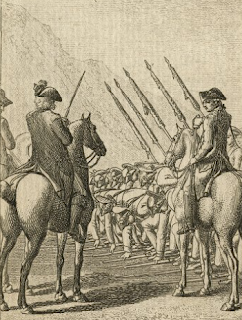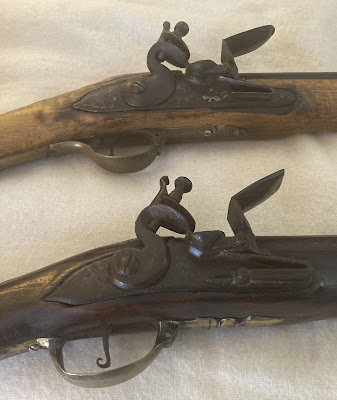Article I of the
Articles of Convention required Lieutenant-General John Burgoyne's British and German soldiers to
"march out of their camp" on the morning of October 17, 1777,
"... to the verge of the river where the old fort stood, where the arms and artillery are to be left; the arms to be piled by word of command from their own officers." [1]
Burgoyne was very specific with regard to this point. On October 14th, Major-General Horatio Gates had proposed to Burgoyne that once terms were agreed to, "... the troops under his excellency General Burgoyne's command, may be drawn up in their encampment, when they will be ordered to ground their arms, and may thereupon be marched to the riverside, to be passed over on their way towards Bennington." [2]
Burgoyne initially replied to Gates: "If General Gates does not mean to recede from the first [Burgoyne's troops surrender as prisoners of war] and sixth [Burgoyne's troops ground their arms in their camp] articles of his proposals, the treaty to end and hostilities immediately commence." Burgoyne followed up with a detailed response to Gates' proposal, which stated: "This article [6th] inadmissible in any extremity; sooner than this army will consent to ground their arms in their encampment, they will rush on the enemy, determined to take no quarter." [3]
Burgoyne then proposed articles of his own, which specified with regard to the surrendering of arms: "The troops to march out of their camp with the honours of war, and the artillery of the intrenchments, which will be left as hereafter, may be regulated." Gates countered on 15th with language which read: "The troops to march out of their camp, with the honours of war, and the artillery of the intrenchments to the verge of the river, where the old fort stood, where their arms and artillery must be left." [4]
The finalized terms of Articles of Convention added the phrase "
the arms to be piled by word of command from their own officers." This allowed Burgoyne's soldiers to march out of their camp and lay down their arms under the command of their own officers, out of sight of the American army, except for a handful of officers who would witness their surrender. Burgoyne noted in a
letter to Sir William Howe, commander-in-chief of British land forces in North America, on October 20th:
"Your Excellency will observe by the papers transmitted herewith, the disagreeable prospect that attended the first Overtures. The Army determined to die to man rather than submit to Terms repugnant to national & personal Honor. I trust you will think the Treaty enclosed consistent with both." [5
]
The majority of the arms surrendered were smoothbore flintlock muskets. British or German, muskets were loaded and fired the same way, using a series of steps each soldier was trained to follow. Soldiers generally used a cartridge, a rolled paper tube packed with a round lead musket ball at one end, and a charge of powder sufficient to both prime the pan and propel the projectile when the musket was fired. [6] After biting off the end of the cartridge away from the ball, the soldier poured a small amount of gunpowder in a pan on the lock on the side of his firearm. The remainder of the powder was poured down the barrel, followed by the ball and the paper cartridge which were pushed to the bottom using a ramrod.
Once loaded, each soldier brought his firearm to the firing position when ordered to do so, took aim, and pulled the trigger. Doing so activated the firing mechanism, the "flintlock" of the musket, which consisted of a plate metal plate fitted with springs which would drive the "cock", which held a piece of flint in its jaws, into the "hammer" which was over the priming pan. Hopefully there would be a shower of sparks which would ignite the priming charge, generate a flame which would pass through a hole in the barrel of the gun, and ignite the main charge to fire the gun. A worn flint, damp powder, fouled venthole or any number of other things could result in a "flash in the pan" (just the priming charge igniting) or a misfire.
Most British soldiers carried a Land Pattern musket. While commonly referred to now as the "Brown Bess" musket, period sources tend to refer to these arm as the "King's Pattern" musket, or words to that effect. The Long Land Pattern, adopted around 1730, had a forty-six inch barrel, .75 inch bore, wood ramrod, and brass furniture; and carried an bayonet with a triangular blade about sixteen or so inches long, on a socket base that fit over the muzzle of the barrel. The Short Land Pattern, adopted as the standard arm for Great Britain's infantry troops in 1768, was similar in design but most notably had a forty-two inch barrel and iron ramrod. [7]
Burgoyne's German troops carried smoothbore flintlock muskets also. The shape of the stock, lock and furniture (metal parts such as on the butt of the musket's stock, the side of the stock opposite the lock and the trigger guard) of German muskets varied from those carried by the British, but functionally they were simila
r. As seen in these two examples, the iron pan and brass furniture of the German musket at the bottom are more squared than the British example at the top, but both locks function in the same manner. There were also variations in design in the arms used by soldiers in different roles, types of units, and even between regiments. [8] British sergeants, as well as light infantry, cavalry and artillery troops sometimes carried carbines, a lighter, scaled down version of the standard musket, with a shorter barrel. The 1756 British Artillery Carbine for example, had thirty-seven inch barrel, with a .66 caliber bore, as explained in this YouTube video produced by Fort Ticonderoga. The muskets of at least one British regiment varied in design from the standard Land Pattern muskets. Muskets associated with the British 53rd Regiment of Foot, stationed in part at Fort Ticonderoga at the time of Colonel Brown's raid in September, have barrels forty-three and a half inches long, and lack wristplates. [9]
Some officers carried personally owned firearms, often referred to as fusils. These too were generally smaller, lighter versions of a musket, and privately purchased. Lieutenant-Colonel James Wilkinson recalled that at a point when the surrender negotiations appeared to have failed, he chided his British counterpart saying "I am sorry for it, as you will now not only lose you fusee, but your whole baggage." Apparently its owner, Lieutenant-Colonel Nicholas Sutherland of the 47th Regiment of Foot, had asked him to exempt it from surrender "... as she was his favorite piece." which he had owned for thirty-five years. [10]
Once Burgoyne's troops had
surrendered their arms and marched off, Americans were curious to see what they had left behind. Though Gates had taken steps to prevent looting, Chaplain Enos Hitchcock went to the surrender field and their camp, where he observed:
"... the British Troops locked their Arms, the Germans grounded theirs... went over their Camp, find Lines very Slender, find much mischief done to Guns, Drums &c - ..." [11]
Following Burgoyne's surrender, the Northern Army of the United States was able to report that: "five thousand stand of arms are taken..." [12] What was a stand of arms though? Another question for another time, and one asked in 1777.
[1]
Articles of Convention, Article I.
[2] Wilkinson,
Memoirs Of My Own Time, vol. 1, 305.
[3] Wilkinson,
Memoirs Of My Own Time, vol. 1, 305.
[4] Wilkinson, Memoirs Of My Own Time, vol. 1, 306.
[5] Francis, F. Wilshin, "Preliminary Report on the Source Material of the Burgoyne Campaign", Saratoga National Historical Park, April 29, 1940, V-VI.
[6] At times, multiple smaller projectiles were loaded, either a half-dozen or so "buckshot" or a few buckshot with a musket ball. A newspaper in British held Newport, Rhode Island, reported: “We are informed that the reason so many brave men and officers were lost under General Burgoyne was, the American musket cartridges were made up one ball and two buck-shot, which killed our men outright, or left them cripples forever, by being wounded in two or three different places at once.” Newport Gazette, April 9, 1778.
[7] Bill Ahern, Muskets Of The Revolution (Lincoln, RI: Andrew Mowbray Publishers, 2005), 24 and 56. Eric Goldstein, The Socker Bayonet In The British Army 1687-1783 (Lincoln, RI: Andrew Mowbray Publishers, 2000), 41-78.
[8] While a handful of Burgoyne's force carried rifles, it was Colonel Daniel Morgan's Virginia riflemen who made the most effective use of these weapons. When asked "Were not the riflemen, and other irregulars, employed by the enemy at out-posts and on scouts, an overmatch for the Indian or provincial troops that were with the army at that time?", Lord (Major Alexander Lindsay) Balcarres of the 53rd Regiment of Foot replied: "They were.” [Burgoyne, Expedition From Canada, Evidence, 42.] One of Burgoyne's German officers would note: "The tactics customary in Europe are not suitable for the countries, neither can bayonets nor other arms or artillery be used to advantage, at least very seldom, except good rifles." [Du Roi the Elder, Journal of Du Rou the Elder, 107.]
[9] Ahern, Muskets Of The Revolution, 50.
[10] Wilkinson, Memoirs Of My Own Time, vol. 1, 316.
[11] Hitchcock, Diary of Enos Hitchcock, 159.
[12] Wilkinson, Memoirs Of My Own Time, vol. 1, 322.
For more on the Convention Army's 1777 march from Saratoga to Boston, see:





Comments
Post a Comment